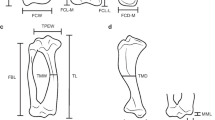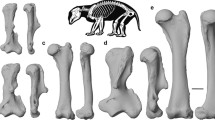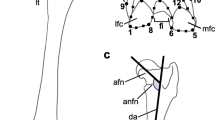Abstract
Xenarthra, one of the major clades of placentals, comprises two different lineages (sloths and anteaters, and armadillos) with extant representatives showing strongly different morphologies and life habits. Sloths are arboreal herbivores, anteaters are insectivores with digging/climbing abilities, and armadillos are terrestrial diggers with varied diets. The ulna is one of the forelimb elements that exhibits distinct morphological specializations for different abilities (e.g., digging and climbing). A sample of xenarthrans was analyzed in this work from a functional and ecological perspective, using 2-D geometric morphometry. The analyses performed were a Principal Components Analysis (PCA), a regression of the shape on the centroid size, and a PCA with the residuals from the regression. The first PCA shows that the morphospace is strongly influenced by differences in length of the olecranon with respect to the shaft between the three clades. Allometry was detected for the whole sample. In the residual PCA, the allometry-free morphospace allows the differentiation between the ecological categories of substrate preference: armadillos and giant anteaters (terrestrial) are located towards the negative side of PC1, while sloths and silky anteaters (arboreal) are located near the positive end, with collared anteaters (semiarboreal) placed near the center. The terrestrial taxa present a more robust diaphysis, and a comparatively long, diaphysis-aligned olecranon, while the arboreal taxa show a relatively long ulna with an anteriorly curved shaft and an anteriorly deflected carpal facet. The ulnar curvature has biomechanical implications in relation to the bone response to different loadings produced in the context of posture and locomotion in each substrate.






Similar content being viewed by others
Data Availability
All data generated during our analyses in the current study are available from the corresponding author on reasonable request.
References
Abba AM, Tognelli MF, Seitz VP, Bender JB, Vizcaíno SF (2012) Distribution of extant xenarthrans (Mammalia: Xenarthra) in Argentina using species distribution models. Mammalia 76: 123–136
Adams, DC, Collyer ML, Kaliontzopoulou A (2018) Geomorph: software for geometric morphometric analyses. R package version 3.0.6. https://cran.r-project.org/package=geomorph
Amson E, Nyakatura JA (2017) The postcranial musculoskeletal system of xenarthrans: insights from over two centuries of research and future. J Mammal Evol. https://doi.org/10.1007/s10914-017-9408-7
Amson E, Nyakatura JA (2018) Palaeobiological inferences based on long bone epiphyseal and diaphyseal structure - the forelimb of xenarthrans (Mammalia). bioRxiv: 318121, ver. 5 peer-reviewed and recommended by PCI Paleo. https://doi.org/10.1101/318121
Argot C (2001) Functional-adaptive anatomy of the forelimb in the Didelphidae, and the paleobiology of the Paleocene marsupials Mayulestes ferox and Pucadelphys andinus. J Morphol 247: 51–79
Bargo MS, Vizcaíno SF, Archuby F, Blanco RE (2000) Limb bone proportions, strength and digging in some Lujanian (late Pleistocene-early Holocene) mylodontid ground sloths (Mammalia, Xenarthra). J Vertebr Paleontol 20: 601–610
Bookstein FL (1989) Principal warps: thin-plate splines and the decomposition of deformations. IEEE T Pattern Anal 11: 567–585
Cassini GH, Vizcaíno SF, Bargo MS (2012) Body mass estimation in early Miocene native South American ungulates: a predictive equation based on 3D landmarks. J Zool 287: 53–64
Delsuc F, Vizcaíno SF, Douzery EJP (2004) Influence of Tertiary paleoenvironmental changes on the diversification of South American mammals: a relaxed molecular clock study within xenarthrans. BMC Evol Biol 4:11
Ercoli MD, Prevosti FJ (2011) Estimación de masa de las especies de Sparassodonta (Mammalia, Metatheria) de edad Santacrucense (Mioceno temprano) a partir del tamaño del centroide de los elementos apendiculares: inferencias paleoecológicas. Ameghiniana 48: 462–479
de Mendiburu F (2019) agricolae: statistical procedures for agricultural research. R package version 1.3-1. https://CRAN.R-project.org/package=agricolae
Fujiwara SI, Endo H, Hutchinson JR (2011) Topsy-turvy locomotion: biomechanical specializations of the elbow in suspended quadrupeds reflect inverted gravitational constraints. J Anat 219:176–191
Gardner AL (2007) Magnorder Xenarthra. In: Gardner AL (ed) Mammals of South America; Vol I Marsupials, Xenarthrans, Shrews, and Bats. University of Chicago Press, Chicago, pp 127–177
Grand TI (1978) Adaptations of tissue and limb segments to facilitate moving and feeding in arboreal folivores. In: Montgomery G (ed) The Ecology of Arboreal Folivores. Smithsonian Institution Press, Washington, pp 231–241
Henderson K, Pantinople J, McCabe K, Richards HL, Milne N (2017) Forelimb bone curvature in terrestrial and arboreal mammals. PeerJ. doi https://doi.org/10.7717/peerj.3229
Hildebrand M, Goslow GE (2001) Analysis of Vertebrate Structure, 5th ed. Wiley, New York
Kay RF (2019) Leonard B. Radinsky (1937–1985), radical biologist. J Mammal Evol. https://doi.org/10.1007/s10914-019-09479-4
Kendall DG (1986) [Size and Shape spaces for landmark data in two dimensions]: comment. Stat Sci 1:222–226
Kilbourne BM, Hutchinson JR (2019) Morphological diversification of biomechanical traits: mustelid locomotor specializations and the macroevolution of long bone cross-sectional morphology. BMC Evol Biol. https://doi.org/10.1186/s12862-019-1349-8
Klingenberg CP, Zimmermann M (1992) Static, ontogenetic, and evolutionary allometry: a multivariate comparison in nine species of water striders. Am Nat 140:601–620
McDonald HG (2003) Xenarthran skeletal anatomy: primitive or derived? (Mammalia, Xenarthra). Senck Biol 83: 5–17
McDonald HG, De Iuliis G (2008) Fossil history of sloths. In: Vizcaíno SF, Loughry WJ (eds) The Biology of the Xenarthra. University Press of Florida, Gainesville, pp 24–36
McDonald HG, Vizcaíno SF, Bargo MS (2008) Skeletal anatomy and the fossil history of the Vermilingua. In: Vizcaíno SF, Loughry WJ (eds) The Biology of the Xenarthra. University Press of Florida, Gainesville, pp 64–78
Mendel FC (1981) The hand of two-toed sloths: its anatomy and potential uses relative to size of support. J Morphol 169: 1–19
Mendel FC (1985) Adaptations for suspensory behavior in the limbs of two-toed sloths. In: Montgomery GG (ed) The Ecology and Evolution of Armadillos, Sloths and Vermilinguas. Smithsonian Institution Press, Washington, pp 151–162
Miller RA (1935) Functional adaptations in the forelimb of the sloths. J Mammal 16: 38–51
Milne N (2016) Curved bones: an adaptation to habitual loading. J Theor Biol 407: 18–24
Milne N (2019) Curved bones: primate ulna in arboreal and terrestrial species. J Morphol 280: S18
Muñoz NA, Toledo N, Candela AM, Vizcaíno SF (2019) Functional morphology of the forelimb of early Miocene caviomorph rodents from Patagonia. Lethaia 52:91–106
Nowak RM (1999) Walker’s Mammals of the World, 6th ed. Johns Hopkins University Press, Baltimore
Nyakatura JA (2012) The convergent evolution of suspensory posture and locomotion in tree sloths. J Mammal Evol 19:225–234
R Core Team (2018) R: a language and environment for statistical computing. R Foundation for Statistical Computing, Vienna (https://www.R-project.org/)
Radinsky LB (1987) The Evolution of Vertebrate Design. University of Chicago Press, Chicago
Rasband WS (1997–2007) ImageJ. US National Institute of Health, Bethesda
Rodrigues FHG, Medri IM, de Miranda GHB, Camilo-Alves C, Mourao G (2008) Anteater behavior and ecology. In: Vizcaíno SF, Loughry WJ (eds) The Biology of the Xenarthra. University Press of Florida, Gainesville, pp 257–68
Rohlf FJ (2015) The tps series of software. Hystrix 26:1–4
Shimer HW (1903) Adaptation to arboreal, aquatic and cursorial habits in mammals. Am Nat 37: 651–825
Springer MS, Murphy WJ, Eizirik E, O’Brien SJ (2002) Placental mammal diversification and the Cretaceous–Tertiary boundary. Proc Natl Acad Sci USA 100: 1056–1061
Taylor BK (1978) The anatomy of the forelimb in the anteater (Tamandua) and its functional implications. J Morphol 157: 347–368
Taylor BK (1985) Functional anatomy of the forelimb in vermilinguas (anteaters). In: Montgomery GG (ed) The Evolution and Ecology of Armadillos, Sloths, and Vermilinguas. Smithsonian Institution Press, Washington, pp 151–171
Toledo N (2016) Conceptual and methodological approaches for a paleobiological integration: the Santacrucian sloths (early Miocene of Patagonia) as a study case. Ameghiniana 53: 100–141
Toledo N, Bargo MS, Cassini GH, Vizcaíno SF (2012) The forelimb of early Miocene sloths (Mammalia, Xenarthra, Folivora): morphometrics and functional implications for substrate preferences. J Mammal Evol 19: 185–198
Toledo N, Bargo MS, Vizcaíno SF (2013) Muscular reconstruction and functional morphology of the forelimb of early Miocene sloths (Xenarthra, Folivora) of Patagonia. Anat Rec 296:305–325
Vizcaíno SF, Bargo MS (2019) Views on the Form-Function correlation and biological design. J Mammal Evol. https://doi.org/10.1007/s10914-019-09487-4
Vizcaíno SF, Bargo MS, Cassini GH, Toledo N (2016) Forma y función en paleobiología de vertebrados. Edulp, La Plata
Vizcaíno SF, Blanco ER, Bender BJ, Milne N (2011) Proportions and function of the limbs of glyptodonts. Lethaia, 44: 93–101
Vizcaíno SF, Fariña RA, Mazzetta G (1999) Ulnar dimensions and fossoriality in armadillos and other South American mammals. Acta Theriol 44: 309–320
Vizcaíno SF, Loughry WJ (2008) Xenarthran biology, past present and future. In: Vizcaíno SF, Loughry WJ (eds) The biology of the Xenarthra. University Press of Florida, Gainesville, pp 1–7
Vizcaíno SF, Milne N (2002) Structure and function in armadillo limbs (Mammalia: Xenarthra: Dasypodidae). J Zool 257: 117–127
Vizcaíno SF, Zárate M, Bargo MS, Dondas A (2001) Pleistocene large burrows in the Mar del Plata area (Buenos Aires Province, Argentina) and their probable builders. Acta Palaeontol Pol 46: 157–169
Young RJ, Coelho CM, Wieloch DR (2003) A note on the climbing abilities of the giant anteaters, Myrmecophaga tridactyla (Xenarthra, Myrmecophagidae). Bol Mus Biol Mello Leitão, Nova Sér 15: 41–46
Zar JH (1999) Biostatistical Analysis, 4 ed. Prentice Hall, Eryelwood Cliffs
Zelditch ML, Swiderski DL, Sheets HD, Fink WL (2004) Geometric Morphometrics for Biologists: A Primer. Elsevier, New York
Acknowledgements
We thank the following persons and institutions: D. Verzi and I. Olivares (MLP), Pablo Teta (MACN), N. Simmons (AMNH), and B. Patterson (FMNH) for access to mammalogy collections; to the organizers of the XXXI Jornadas Argentinas de Mastozoologia, A. Chemisquy and F. Prevosti for allowing GHC and NT to organize the symposium “El paradigma de correlación forma-función en mastozoología: un tributo a Leonard Radinsky (1937–1985)”; La Rioja, Argentina, October 25th, 2018. To S.F. Vizcaíno and M.S. Bargo for introducing us to the impressive work and conceptualizations of Radinsky. The comments and corrections of the Editor and Guest Editor, Nick Milne, and one anonymous reviewer greatly enhanced this manuscript. This is a contribution to the projects PICT 2013 − 0143 of the Agencia Nacional de Promoción Científica y Tecnológica (ANPCyT) and Universidad Nacional de La Plata (UNLP) N750.
Author information
Authors and Affiliations
Corresponding author
Electronic Supplementary Material
Online Resource 1
(PDF 60 kb)
Online Resource 2
(PDF 274 kb)
Online Resource 3
(PDF 124 kb)
Online Resource 4
(PDF 1082 kb)
Online Resource 5
(PDF 74 kb)
Online Resource 6
(PDF 65 kb)
Rights and permissions
About this article
Cite this article
Toledo, N., Muñoz, N.A. & Cassini, G.H. Ulna of Extant Xenarthrans: Shape, Size, and Function. J Mammal Evol 28, 35–45 (2021). https://doi.org/10.1007/s10914-020-09503-y
Received:
Revised:
Accepted:
Published:
Issue Date:
DOI: https://doi.org/10.1007/s10914-020-09503-y




